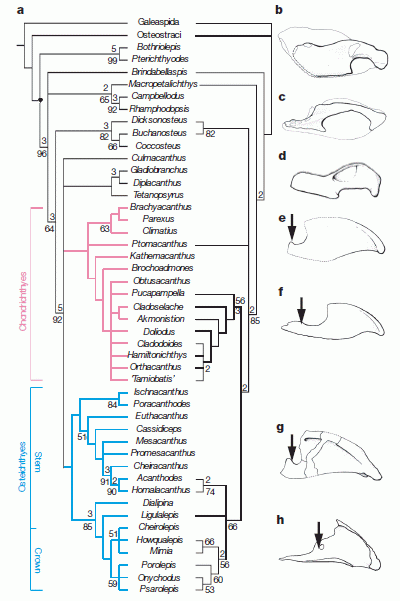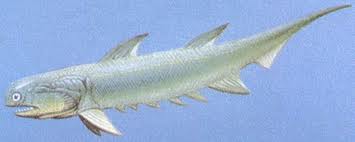Acanthodii: Ptomacanthus
Taxa on This Page
- Acanthodii X
- Climatiiformes X
- Eugnathostomata
- Ptomacanthus X
The acanthodians are a group of mostly small somewhat shark-like looking early jawed fishes with sharp spines along the leading edges of all fins (except for the tail fin). Until recently their evolutionary significance and relationships to modern jawed vertebrates, have been poorly understood, because very little was known about features of the braincase, the internal head skeleton that is important in understanding early vertebrate phylogeny. Only data on a single, late, highly derived genus, Acanthodes, was known. Because the braincase of Acanthodes is similar to that of bony fish, it was thought that the Acanthodii and Osteichthyes (bony fish) share a common ancestor separately from other groups like sharks. The clade based on this common ancestor has been called Teleostomi
That whole picture changed in 2009 when Uppsala University researcher Martin Brazeau published an important paper in Nature describing the skull and jaws of a fish of the acanthodian Ptomacanthus anglicus, an earlier and more basal form than Acanthodes

Comparison of neurocranial proportions (ventral view) in early gnathostome taxa, drawn to same length. Ptomacanthus braincase is shown inside the reconstructed head skeleton. The horizontal blue line demarcates the approximate boundary between prechordal and parachordal regions of the braincase, with the position of the postorbital process used as a proxy. Arrows indicate position of palatoquadrate articulation. Na.ca, nasal capsules, or their corresponding position; V.cran.fi, ventral cranial fissure. Brazeau 2009 p.306. Graphic © 2009 Macmillan Publishers Limited. |

Phylogenetic analyses showing strict consensus cladograms of the 2,904 shortest trees from the global analysis (left) and the 30 most parsimonious trees from the endocranial data set (right). Double digits indicate percentage bootstrap support; single digits show Bremer decay indices (when greater than 1). . On the far right are selected gnathostome palatoquadrates: b, Bothriolepis. c, Buchanosteus. d, Tetanopsyrus. e, Ptomacanthus. f, Cladodoides. g, Acanthodes. h, Mimia. Vertical arrow shows position of palatoquadrate-braincase articulation that corresponds to the basipterygoid articulation shown in the above diagram. Brazeau 2009 p.307. Graphic © 2009 Macmillan Publishers Limited. |
Ptomacanthus is not a new discovery; it was first described about 30 years ago. But this is the first time the animal's braincase has been described, and this proved very significant, as it shares plesiomorphic characters shared with sharks and placoderms. This calls into question previous association with the bony fishes. From the abstract (included in the Press release) "I present details on the morphology of the braincase of Ptomacanthus, which is more than 100 million years older than Acanthodes. It is a radically different morphology from Acanthodes, which has several important implications for the relationships of acanthodians. The braincase of Acanthodes appears to most closely resemble that of early bony vertebrates, the lineage that ultimately includes humans and other land-living vertebrates). For this reason, the acanthodians were thought to share a closer ancestor with bony vertebrates than with sharks. However, the braincase of Ptomacanthus more closely resembles that of early shark-like fishes, and shares very few features in common with Acanthodes and the bony vertebrates. As a consequence, the results indicate that Ptomacanthus was either a very early relative of sharks, or close to the common ancestry of all modern jawed vertebrates" (Eureka alert and other links)
Previous cladistic hypotheses of acanthodian relationships have focused on their sister-group relations with chondrichthyans or osteichthyans. All of these studies assumed acanthodian monophyly based on the morphology of Acanthodes, the last and most highly derived (apomorphic) genus." Brazeau's cladistic analysis used 45 ingroup and two outgroup taxa and 134 characters. The results are presented at the left:
These findings would seem to pretty strongly refute acanthodian monophyly. Depending on the data and methodology used, Ptomacanthus is, like Climatius, a basal stem chondrichthyan, or forms a trichotomy with Chondrichthyes and Teleostomi. Significantly, the placoderms also come out as paraphyletic (ontra Janvier). As Brazeau concludes:
"Current conceptions of gnathostome phylogeny depict a rather simplistic arrangement of nominally monophyletic and, apparently, morphologically disparate groups. The emerging picture of acanthodian (and perhaps placoderm) paraphyly does not overturn a general consensus about gnathostome interrelationships. Instead, it populates the long, naked internal branches, revealing a much richer picture of character evolution in early gnathostomes."
Brazeau 2009 p.307
MAK110930

Climatius, a representative eugnathostomate (Acanthodian). Late Silurian; length about 8 cm. image from www.prehistoria.piwko.pl, copyright © whoever the artist is. |
Eugnathostomata - the "True Jaws"
There's really not much in the way of apomorphies to distinguish the Eugnathostomata from other branching points in the vertebrate cladogram, although we have listed a few characteristics. The common ancestor here would have rather resembled a Climatiiform fish, like the one illustrated above. From a humble yet innovative creature like this, sometime and somewhere in the Silurian, the two great branches of fish evolution, the Chondrichthyes or sharks and rays (cartiligeous fish) and the Osteichthyes or bony fish, arose. MAK110930
Descriptions
Eugnathostomata:
Range: fr O?.
Phylogeny: Gnathostomata : Placodermi + * : Ptomacanthus + (Climatiiformes + Chondrichthyes) + Teleostomi.
Characters: Teeth rooted or in whorl; teeth replaced (but Acanthodii?); postorbital artiulation between palatoquadrate and braincase; hyomandibular jaw support; modifications (?) of extrinsic eye muscles; internal fertilization (all modern forms)? ATW010810.
 Acanthodii: Acanthodus.
Acanthodii: Acanthodus.
Update: Hanke & Wilson (2006) have redescribed Brochoadmones, an acanthodian of uncertain affinities, on the basis of superlative material from the MOTH locality in Northerrn Canada. As originally reported, it looked a great deal like our image of Acanthodes. Among many new and interesting features, two points stand out. First, in addition to the ventral spine pairs, Brochoadmones has a thin, very osteichthyan pectoral fin, located about midway up the body wall. The fin has a short pectoral fin spine (much shorter than the fin) "resembling a bivalve shell" but no ossified endoskeleton. The implication seems to be that the osteichthyan pectoral fin is only indirectly related to the usual ventral fin spines of the acanthodians. Second, the head turns out to be very small, the fish being deep-bodied and almost trapezoidal overall. ATW061003.
Further update: Brazeau 2009 persuasively argues for the paraphyly of the acanthodians, which would in cladistic terms, make them synonymous with Eugnathostomata. For now however, and pending further revision, the present entry is retained as is. MAK110930
Crania based on 4 large plates bridged by cartilage; subterminal mouth; branchiostegal rays present; no enamel on teeth, teeth not regularly replaced; jaws of dermal bone; orbits large and far anterior, with circumorbital plates; bony operculum; branchiostegal rays present; otoliths in inner ear; narrow-based braincase with a transverse ventral fissure; braincase & otic capsule well-ossified; primitively, several opercular scales; vertebral centra not ossified; no ribs; heterocercal tail; fin spines on all except caudal fins; generally membranous fins without rays except for spines; various articulations of pectoral spine with shoulder girdle; up to 6 paired intermediate spines between pectoral and pelvic fins; scales like Chondrichthyes, but no pulp cavity: base bulges & new odontodes of dentine or mesodentine surround and overgrow old with layered effect; fins covered with similar scales, like lepidotrichia of Osteichthyes; cranial large scales not homologous to Osteichthyes.
Links: acanthodii.htm; Replicas of Paleozoic Fishes; Acanthodii; Paleontology and Geology Glossary; Zajic 1988 jaws.pdf; Primative Fish & the Evolution of Jaws & Lungs; Acanthodii Placodermi Slovenian: apparantly a nice summary); Genomgång Osteichthyes (Swedish: introduction to the Osteichthyes with a brief section on the Acanthodii); OTHER FISH (the usual amazing images from this site); Various other relevant short papers & abstracts by Zaijicat Publications). APW 040806. HAJ100226; Acanthodii - in Russian, description plus various reconstructions and pghotos of fossils; Devonian Times: more about Acanthodians; Wikipedia and List of acanthodians (tho when last I checked the latter most taxa were redlinks (no entry)
Ptomacanthus: Ptomacanthus anglicus
Range: Early Devonian of England. Wayne Herbert Quarry (pdf) Lagerstatte, Herefordshire, England, Lochkovian,
Phylogeny: Eugnathostomata : (Climatiiformes + Chondrichthyes) + Teleostomi + *.
Characters: . A transitional and highly plesiomorphic form that seems to have few apomorphies. Shares with the Climatiidae paired median and paired pre-pelvic (or intermediate) fin spines and tessellated dermal cranial covering; braincase plesiomorphic, with extremely short sphenoid region intermediate between some Palaeozoic chondrichthyans and osteichthyans, as is type of jaw suspension. (Brazeau 2009)
Comments: The little fish that revolutionised evolution. Originally described as a Climatiid acanthodian, extensive examination of its braincase and cladistic analysis led Martin Brazeau to propose it was either a declare it either a stem Chondrichthyan, or a sister-taxon intermediate between true sharks and teleostomi (derived acanthodians and bony fish) MAK110930
 Climatiiformes: Climatius.
Climatiiformes: Climatius.
May be paraphyletic basal group. Generally small-bodied (<15 cm); teeth minute & petalliform, not shed; extramandibular absent; palatoquadrate elongate & without otic articulation; 1 large and several small gill covers; broad-based spines with ridges; 2 dorsal fins; 2+ intermediate spines between pectoral and pelvic fins; well-developed dermal pectoral plates.
Comments: The Acanthodii are here considered paraphyletic MAK110930
Note: The orbit shown in the image may be a bit small and there may be one too many sets of intermediate spines. APW 040806.
page last modified MAK110930
checked ATW 040806.







